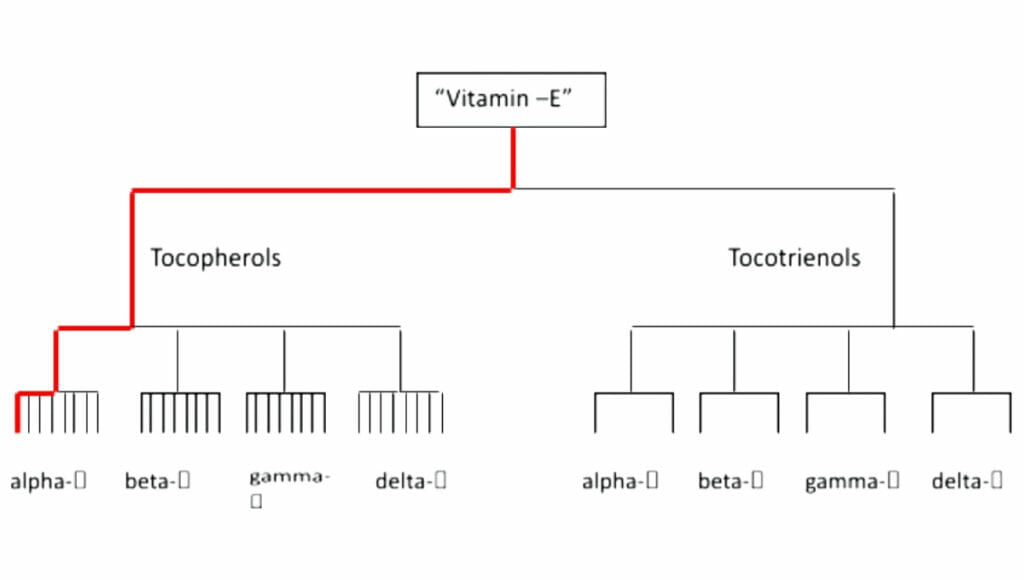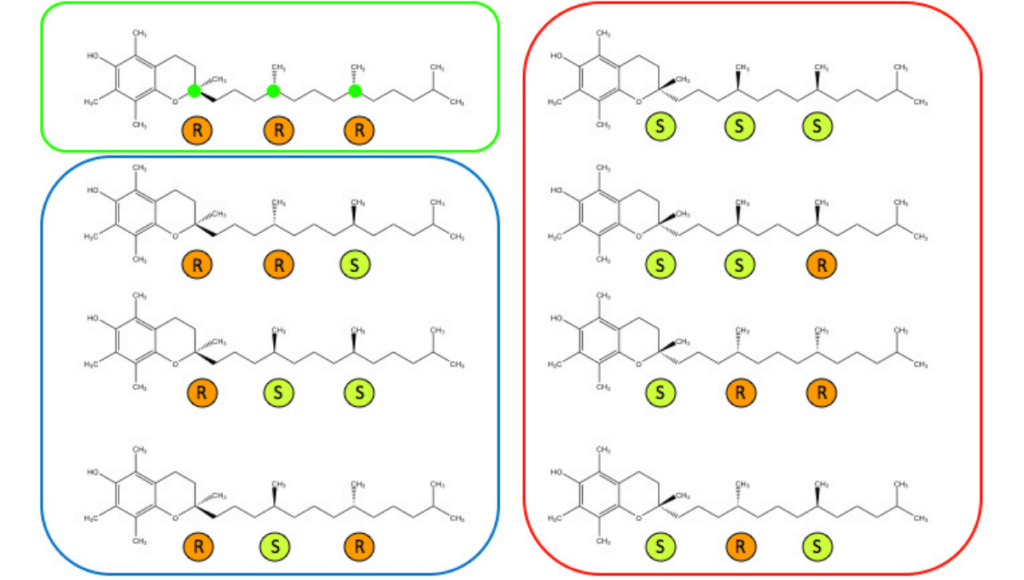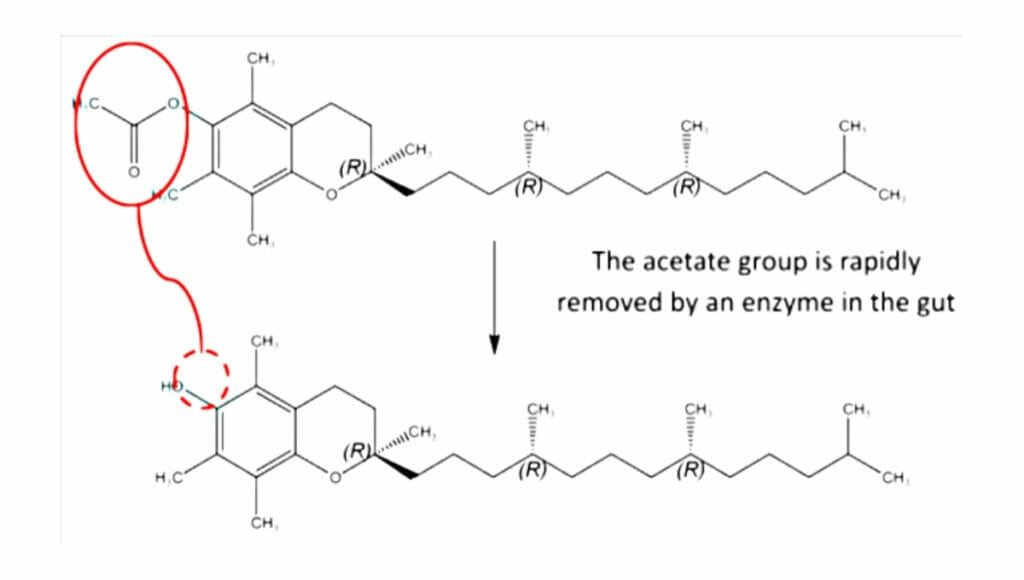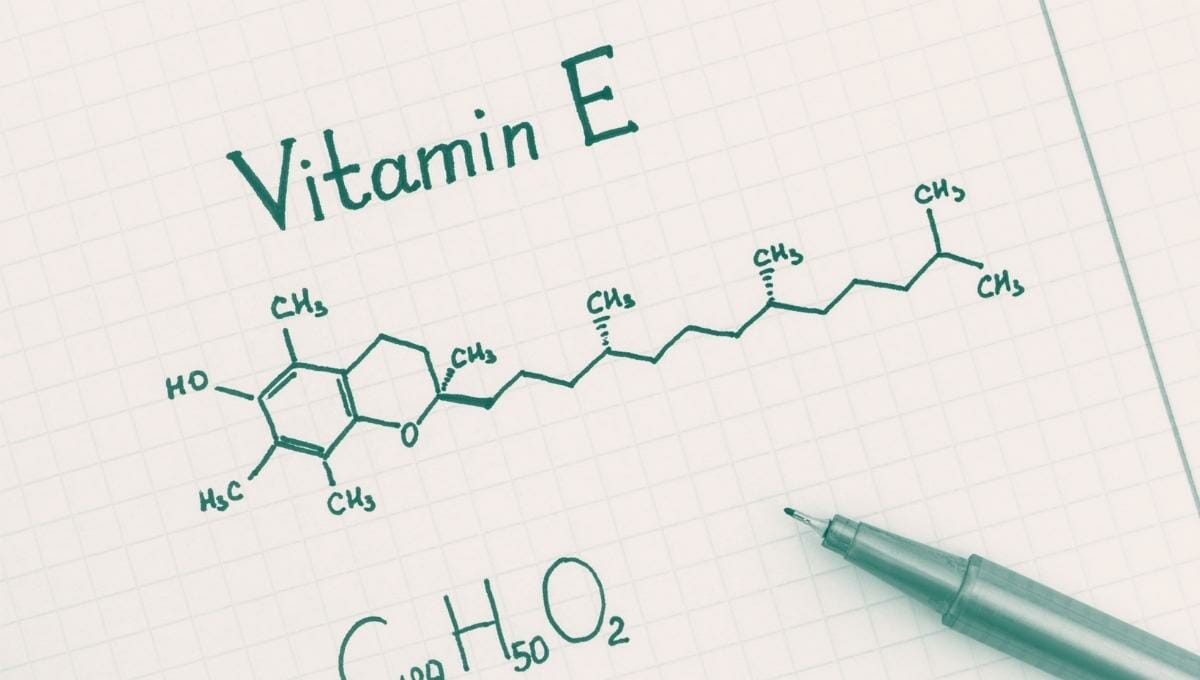Would you like to know about natural versus synthetic Vitamin E for horses? Is there a difference between the two forms of vitamin E for horses?
Which form of vitamin E is best to feed to your horse? Find out what vitamin E actually is and the difference between the synthetic and natural versions.
Vitamin E is an essential vitamin that acts as an important fat-soluble antioxidant. The beneficial effect of this vitamin, on your horse’s health, has been described here at Forageplus Talk.
Tocopherols and Tocotrienols
Vitamin E is not a single substance but refers to a collection of different compounds that are all related to each other through a common chemical framework. Vitamin E consists of two classes of compounds called tocopherols and tocotrienols. Each class contains a further four sub-groups of compounds that are designated alpha (α), beta (β), gamma (γ) and delta (δ). Furthermore, each of these sub-groups exists in different forms called stereoisomers.
There are eight stereoisomers for each alpha, beta, gamma and delta form of the tocopherols and two stereoisomers for each alpha, beta, gamma and delta form of the tocotrienols. What is commonly referred to as “natural vitamin E” is just one stereoisomer of the alpha subgroup of tocopherol, this is represented by the red line in the tree diagram below.

The commonly referred to as “natural” and “synthetic” forms of vitamin E only relate to the alpha-tocopherol sub-group which makes our lives easier because in effect we can ignore all the others.
Alpha-tocopherol
As described above alpha-tocopherol can exist in eight distinct stereoisomer forms, but what does this mean? The chemical structures for these eight forms of alpha-tocopherol are shown below but for the time being, just look at the structure shown in the green box.
This structure contains three special centres that have been highlighted with a green dot. Each of these centres can exist in one of two configurations, one is called the “R-configuration” and the other is called the “S-configuration”. The letters “R” and “S” technically describe the spatial arrangement of the atoms around each centre with the R-configuration being the non-superimposable mirror image of the S-configuration.
This is exactly the same as your hands! Your right hand is a mirror image of your left hand but you cannot superimpose one hand onto the other because each thumb lines up with a little finger. Using this analogy the R-configuration can be considered to be the “right-handed” form and the S-configuration the “left-handed” form. For the structure inside the green box, all three of these centres are of the R-form and so this is called RRR-alpha-tocopherol and this is the chemical structure of “natural” vitamin E. It is called “natural” because it is this compound that is produced by nature in a variety of vegetables and seeds. Commercially available natural RRR-alpha-tocopherol is mainly derived from vegetable oils.

The spatial configuration of the atoms that give rise to this “handedness” is very important because in biology proteins and enzymes have evolved to work specifically with one particular configuration. The protein that has evolved to work at transporting vitamin E into the blood plasma is called the alpha-tocopherol transport protein and works best with RRR-alpha-tocopherol. A good analogy is to consider the protein to be a lock and RRR-alpha-tocopherol to be the key that unlocks the door allowing the vitamin to enter the blood.
As each of the centres highlighted by the green dots can exist in either the “right” or “left-handed” R or S configurations and there are eight possible combinations which are the eight so-called stereoisomers that are shown below:

“Synthetic” vitamin E consists of an equal mixture of all eight of these stereoisomer configurations. Remember that only one of these configurations, the RRR configuration is the natural version so as a consequence the concentration of the “natural” RRR-form in synthetic vitamin E is one divided by eight or 12.5%. Synthetic vitamin E may also be called racemic or dl–vitamin E, these are just different names for the same equal mixture of all eight of these stereoisomer forms.
Physical Characteristics of Vitamin E
The eight stereoisomers that constitute alpha-tocopherol exist as oils. These oils are prone to oxidative degradation, i.e. exposure to air causes them to degrade which renders the active RRR-form completely ineffective as a vitamin. In order to improve the stability of alpha-tocopherol for use as a feed supplement, it is often chemically modified through a process known as esterification. The products of the esterification process are generically called esters and the two most common esters used for stabilising alpha-tocopherol are called the acetate ester and the succinate ester. The acetate ester of alpha-tocopherol is by far the most common and is shown below with the ester bit inside the red circle. The addition of this acetate ester group greatly improves the stability of alpha-tocopherol and prevents it from losing its antioxidant properties. When ingested the acetate group is rapidly removed by an enzyme in the gut to give free alpha-tocopherol. Research has demonstrated1 there is no difference between the bioavailability of the acetate and “free” forms of alpha-tocopherol and this is discussed in more detail later.

To facilitate ease of handling for animal feed purposes alpha-tocopherol acetate is adsorbed onto inert silica gel and the product of this process is referred to as an adsorbate. The term “adsorb” means being stuck onto the surface of something, so in this case, it is alpha-tocopherol acetate that is physically stuck onto the surface of the silica. The adsorbate is an easy-to-handle powder that can be accurately measured and distributed into a horse’s feed. Silica gel is essentially a super-pure form of sand that passes cleanly through the gut and is excreted. Silica gel is quite benign and is used, for example, to treat conditions such as bloating and excessive gastrointestinal gas in humans!
The amount of alpha-tocopherol acetate adsorbed onto silica is quoted as a percentage. Synthetic vitamin E acetate adsorbate is typically sold as 50% meaning that 50% by weight is adsorbed onto silica. For example, 16 grams of 50% synthetic vitamin E acetate powder would contain 8 grams of actual synthetic vitamin E acetate. Since we now know synthetic vitamin E acetate is an equal mixture of all eight stereoisomers there would be one gram of each stereoisomer in our 16 grams. Or putting it another way our 16 grams would contain just 1 gram of the desired RRR-form of alpha-tocopherol.
By contrast, the natural vitamin E acetate adsorbate is typically sold as 25% meaning that 25% by weight is adsorbed onto silica. For example, 16 grams of 25% natural vitamin E acetate adsorbate powder would contain 4 grams of the desired RRR-form of alpha-tocopherol.
There are other ways of improving the stability of alpha-tocopherol without producing the ester. Researchers at Kentucky Equine Research have developed a nano-encapsulated form of alpha-tocopherol. In this formulation, a tiny portion of the natural RRR-alpha-tocopherol oil is locked inside a specially designed water-miscible particle that allows the RRR-alpha-tocopherol to become homogeneously distributed throughout the gastrointestinal tract facilitating extremely good bio-uptake. In fact, this form of vitamin E is absorbed into the blood plasma much more readily than even pure natural vitamin E oil, see later.
International Units or IU values
Many biologically important compounds are supplemented based on a metric called the International Unit or IU value. The IU value for a vitamin is a measure based on biological activity and attempts to provide an active measure of the compound absorbed irrespective of its source.
The following table lists some of the common commercial grades of Vitamin E with their respective activities expressed as IU per gram (g) or millilitre (mL)
| Natural or Synthetic | Trade Name | IU/g or mL |
|---|---|---|
| Synthetic acetate adsorbate | Rac-Vitamin E 50%¹ | 500 IU/g |
| Natural acetate adsorbate | Vitamin E 250² | 500 IU/g |
| Natural acetate | Vitamin E 1360² | 1360 IU/g |
| Natural free oil | Vitamin E 1490² | 1490 IU/g |
| Natural succinate | HPMC² | 1162 IU/g |
| Natural encapsulated | Nano E³ | 250 IU/mL |
1. Zhejiang Chemical Co. Ltd; 2. ADM Natural Health and Nutrition; 3. Kentucky Equine Research
Based on this you may think it’s simple to determine how much you need to feed, for example, if you want to feed 2000 IU per day to a 500kg horse you would first choose your product and then simply feed the number of grams or millilitres recommended to provide 2000 IU. There is absolutely nothing wrong with this method and to be honest, this is the approach adopted by most horse owners and feed companies. If however, you want to know how well the vitamin E you are feeding is actually being absorbed into the blood plasma then you have to dig a little deeper and directly address the question of bioavailability.
Bioavailability of Vitamin E
At its simplest bioavailability is a measure of the fraction of an administered drug or in our case vitamin that reaches and is absorbed into the blood plasma. The IU value and bioavailability of a substance should be closely related however confusion can and does occur when IU values have been determined in one species and then those values are transferred onto another species. It is not surprising that biologically people, rats, pigs and horses can behave quite differently!
By definition, if a drug was administered intravenously it would have a bioavailability of 100%. Unlike an intravenous drug, however, we are administering vitamin E orally so the vitamin can only get into the bloodstream via the gut. There has been a lot of research looking at the bioavailability of synthetic and natural vitamin E in a variety of species including humans, pigs, rats and horses. Quite often equivalence ratios are quoted, for example, a common ratio quoted is that synthetic vitamin E has only half the bioavailability of natural vitamin E. Other research has suggested synthetic vitamin E has about 74% of the activity of natural vitamin E2.
The question of whether to feed natural or synthetic vitamin E is a matter of personal choice. There is no doubt the natural form is only supplying exactly what your horse needs however there is no evidence at all to suggest feeding the other stereoisomer compounds that are present in the synthetic form causes any problem. We also know the two most common commercial forms of synthetic and natural vitamin E, the acetate adsorbates, differ in their bioavailability by a factor of two. This means you would have to feed double the quantity of synthetic vitamin E to have the same bioavailable uptake as natural vitamin E.
These numbers arise because some of the other alpha-tocopherol stereoisomers, those shown inside the blue box, are partially absorbed into the blood and contribute to vitamin activity3. Using our lock and key analogy, these isomers are like badly fitting keys, the door will open but you need to rattle the key around a bit for it to do so. The isomers shown inside the red box are not absorbed into the blood at all and are preferentially excreted, again using our analogy these isomers are like keys that simply don’t fit into the lock.
Remember it is only synthetic vitamin E that contains these other 7 isomers. It is important to recognise there are no reports anywhere that suggest ingesting the other isomers is harmful and to reiterate what we have already stated it is known that three of the isomers show some beneficial bioactivity whereas the other four are simply excreted.
The chart below is taken from results published by Kentucky Equine Research into the relative bioavailability of different sources of vitamin E1. Importantly this research was conducted using horses (thoroughbred geldings). The study was carried out by feeding 5000 IU of vitamin E in a single dose from each of the sources listed and then measuring the uptake of the vitamin in the blood plasma of the horses studied. The results show the relative cumulative uptake over a 24-48 hour period.
The work highlights some interesting features:
- There is very little difference between the natural acetate (administered as the adsorbate) and natural vitamin oil. This confirms that “stabilising” vitamin E by making the acetate ester has very little consequence on the bioavailability.
- The natural acetate has about twice the bioavailability of synthetic vitamin E (also administered as the adsorbate). This corroborates research obtained in other animal species.
- The natural encapsulated nano-E formulation has about three times the bioavailability of either the natural acetate or even the natural vitamin oil itself.

The Forageplus view of vitamin E
The question of whether to feed natural or synthetic vitamin E to horses is a matter of personal choice. There is no doubt the natural form is only supplying exactly what your horse needs however there is no evidence at all to suggest feeding the other stereoisomer compounds that are present in the synthetic form causes any problem. We also know the two most common commercial forms of synthetic and natural vitamin E, the acetate adsorbates, differ in their bioavailability by a factor of two. This means you would have to feed double the quantity of synthetic vitamin E to have the same bioavailable uptake as natural vitamin E.
We now know that to achieve the same nominal loading in blood we could feed a specified amount of synthetic vitamin E or half of that amount of natural vitamin E or one-sixth that amount of the specialist product Nano-E. The following table illustrates this based on a nominal 6000 IU dose of synthetic vitamin E:
| Horse Type / Body Weight | Vitamin E Level |
|---|---|
| For an average 500 kg horse | Maintenance needs 2000iu per day. |
| For unwell or stressed horses | 5000 – 10000iu per day. |
| Performance Horses | 3000 – 5000iu per day. |
FP = ForagePlus; synthetic vitamin-E acetate adsorbate £18.99 for 500g; natural vitamin E acetate adsorbate £32.95 for 500g (Feb 2025). KER = Kentucky Equine Research, UK distributor, £94.99 for 450mL (Feb 2025)
At ForagePlus we believe both synthetic and natural vitamin E is equally valid to use. We have highlighted the differences between the two and in particular the differences in their bioavailability. If there is a strong clinical reason to load high levels of vitamin E into the bloodstream as quickly as possible then a specialist product such as Nano-E has benefits, otherwise, the same levels can be achieved more cost-effectively by increasing the quantity of either synthetic or natural vitamin E being fed.
References
- Form of α-tocopherol affects vitamin E bioavailability in thoroughbred horses, J.D. Pagan, M. Lennox, L. Perry, L. Wood, L.J. Martin, C. Whitehouse, and J. Lange, Kentucky Equine Research, Versailles, Kentucky 40383,USA
- Relative bioactivity of dietary RRR- and all-rac-alpha-tocopheryl acetates in swine assessed with deuterium-labeled vitamin E, C. Lauridsen, H. Engel, A.M. Craig, M.G. Traber, J Anim Sci, 2002, 80 (3): 702-7
- α‐Tocopherol Stereoisomers, S. Jensen, C. Lauridsen, Vitamins & Hormones 76: 281–308, 2007
-
 Vitamin E for Horses – Natural£32.95 – £65.90 — or subscribe and save 5%
Vitamin E for Horses – Natural£32.95 – £65.90 — or subscribe and save 5%



